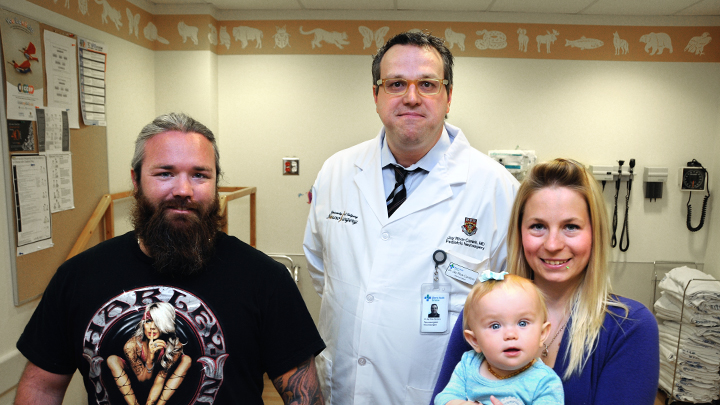
May 24, 2016

Pediatric neurosurgeon Dr. Jay Riva-Cambrin with Lauren Mitchell and Jamie Plessis, whose daughter Baya underwent a revolutionary new surgical procedure for hydrocephalus at Alberta Children's Hospital.
Story by Greg Harris; photo by Paul Rotzinger
CALGARY — Lauren Mitchell and Jamie Plessis’s infant daughter Baya faced an uncertain future in late 2015 when a routine checkup showed her skull was growing too rapidly — a sign of hydrocephalus, a buildup of fluid in the brain.
“We saw a pediatrician, who immediately told us there was pressure building up because of hydrocephalus,” says her mom Lauren. “Baya went in for an MRI right away and then, a week later, she was in surgery.”
Baya turned out to be a good candidate for a revolutionary new surgical procedure offered at Alberta Children’s Hospital in Calgary, which is the only Canadian centre outside of Toronto that offers it.
Performed by neurosurgeon Dr. Jay Riva-Cambrin, the minimally invasive procedure creates new channels for the cerebrospinal fluid to drain and circulate normally. As well, it also eliminates some of the tissue that creates the excess fluid.
Standard practice is to place an internal shunt, or tube, to drain the fluid into the abdominal cavity, where it is reabsorbed by the body. However, infection is a common risk with shunts. People with shunts sometimes face multiple neurosurgeries over their lifetimes to repair the problems that can arise.
“Right now, this is one of the hottest topics in pediatric neurosurgery,” says Dr. Riva-Cambrin, who brought the technique to Calgary last year after receiving training from surgeons in Mbale, Uganda, and Boston Children’s Hospital.
“The quality of life for these children is substantially improved when we can eliminate the risks of infection and the need for implanted hardware. It will be less likely that they’ll have to have more brain surgeries as they grow up.”
The procedure — its full name is endoscopic third ventriculostomy with choroid plexus cauterization (ETV/CPC) — sees the surgeon create a small opening in the skull, then use a tiny camera to guide miniature surgical tools to create a bypass for the blocked cerebrospinal fluid. The second part of the procedure involves cauterizing and thereby disabling some of the choroid plexus, tje type of tissue that creates much of the cerebrospinal fluid.
About two-thirds of infants with hydrocephalus are candidates for the procedure, according to Dr. Riva-Cambrin. Generally, they must be under 24 months and have an MRI that confirms there is minimal scarring in the exit passageway.
About 50 to 60 babies are treated for hydrocephalus in Alberta every year; with about half of those from the Calgary area. Without treatment, pressure from accumulating fluid inside the brain and skull will eventually prove fatal.
Dr. Riva-Cambrin can perform the ETV/CPC procedure on eligible patients from Alberta, eastern B.C. and western Saskatchewan. He’s currently working with colleagues in Edmonton to introduce the procedure there.
Only two neurosurgeons in Canada have been trained in the procedure, says Dr. Riva-Cambrin. It was first developed by Dr. Benjamin Warf as a solution for children in Africa, where medical supports aren’t ideal for the lifelong maintenance of shunts. Dr. Warf then brought the procedure to Boston Children’s Hospital.
Dr. Riva-Cambrin performed about 70 of the procedures in Salt Lake City before moving to Calgary, where he has performed seven since arriving last September.
Today, Baya is back on track with her developmental milestones. And both parents are grateful she doesn’t have a permanent shunt.
“Dr. Riva-Cambrin is a hero to us,” says Baya’s dad Jamie. “He gave us our baby back.”